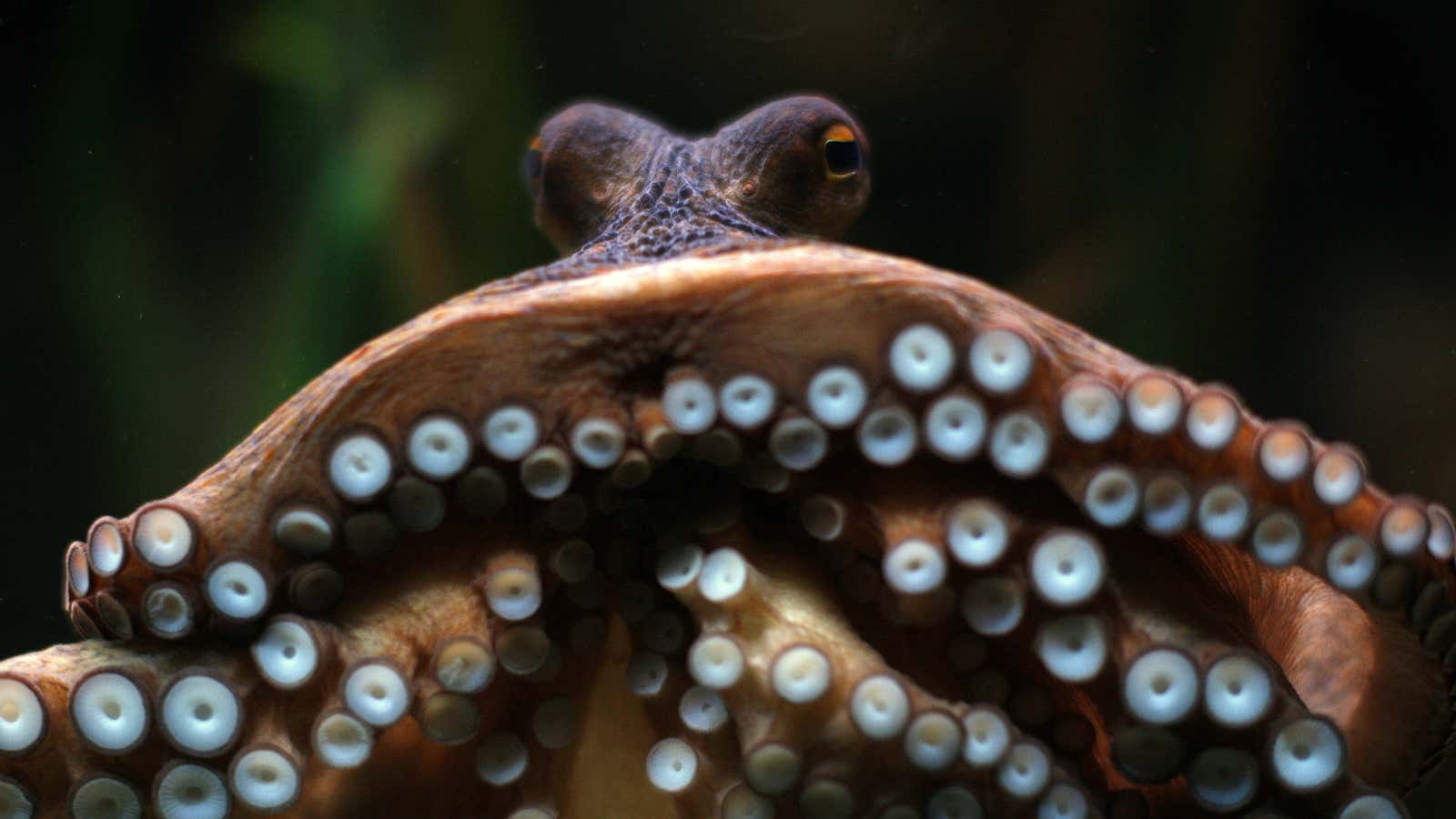This post has been corrected.
We’re in the midst of Cephalopod Week, the fourth annual celebration of octopuses, cuttlefish, nautiluses, and squid launched by the podcast Science Friday in answer to Discovery Channel’s Shark Week. Unlike that marketing juggernaut, which long ago chose sensationalism over science (2017 offerings include “Shark-Croc Showdown,” “Great White Shark Serial Killer Lives,” and the admittedly intriguing “Phelps Vs. Shark: Great Gold Vs. Great White”), Cephalopod Week remains a gleefully geeky embrace of cephalopodic science.
Appropriately, the “week” (which started on June 16) is actually eight days long. Quartz’s science team has compiled eight facts about our favorite tentacled mollusks.
They are incredible mimics
Several octopus species have been observed changing their behavior, body shape, and color to camouflage themselves. Scientists have observed a light-sensitive pigment in octopus skin similar to that found in other animals’ eyes, enabling these split-second transformations. They also have killer acting skills: the mimic octopus, or Thaumoctopus mimicus, has been known to contort itself into passable impressions of sea stars, fish, sea snakes, and other species.
They eat jellyfish
The deep-sea dweller Haliphron atlanticus has been filmed snacking on jellyfish, and further research confirms that jellyfish are a regular part of that octopus’s diet. Its low metabolism rate makes even a low-calorie jellyfish a worthwhile nutritional investment.
They are memorable literary characters
Consider this description of the octopus as a stone-cold killer in John Steinbeck’s novel Cannery Row:
Then the creeping murderer, the octopus, steals out, slowly, softly, moving like a gray mist, pretending now to be a bit of weed, now a rock, now a lump of decaying meat while its evil goat eyes watch coldly. It oozes and flows toward a feeding crab, and as it comes close its yellow eyes burn and its body turns rosy with the pulsing color of anticipation and rage. Then suddenly it runs lightly on the tips of its arms, as ferociously as a charging cat. It leaps savagely on the crab, there is a puff of black fluid, and the struggling mass is obscured in the sepia cloud while the octopus murders the crab. On the exposed rocks out of water, the barnacles bubble behind their closed doors and the limpets dry out. And down to the rocks come the black flies to eat anything they can find. The sharp smell of iodine from the algae, and the lime smell of calcareous bodies and the smell of powerful protean, smell of sperm and ova fill the air. On the exposed rocks the starfish emit semen and eggs from between their rays. The smells of life and richness, of death and digestion, of decay and birth, burden the air. And salt spray blows in from the barrier where the ocean waits for its rising-tide strength to permit it back into the Great Tide Pool again. And on the reef the whistling buoy bellows like a sad and patient bull.
They have multi-day orgies
They are charmingly cute
When scientists went searching for individuals in the genus of deep-sea octopuses known colloquially as “flapjack octopuses,” they chanced upon a new species of big-eyed, heartbreakingly cute little cephalopods. Scientist Stephanie Bush of the Monterey Bay Aquarium Research Institute was tasked with naming the new species. Her pick? Opisthoteuthis adorabilis. “Taxonomy moves at the speed of molasses,” Bush told Quartz, so the cutest name in the sea won’t be official for a few more years.
They have brains in their arms
The nervous system of an octopus has multiple control centers, both in its head and in each of its arms. A severed octopus arm will continue to respond to stimuli even once separated from the rest of a dead animal’s body.
They can make themselves invisible
The Humboldt squid can turn itself dark red. That color’s wavelength doesn’t travel far underwater, rendering the animal virtually invisible to predators and prey. For similar reasons, a National Geographic crew filming the squid used red camera equipment to be as unobtrusive as possible. That did not stop the squid from attacking the videographer and attempting to tear off his mask underwater.
They are freakishly fast
By expelling water and using its fins as sails, the neon flying squid is believed to be able to propel itself through the air at speeds up to 11.2 meters per second. World’s fastest human Usain Bolt managed a mere 10.43 meters per second while setting the world record for the 100 meter sprint in 2009.
Correction: An earlier version of this article identified Science Friday as an NPR podcast. It is independently produced and distributed by Public Radio International.
